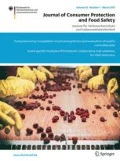Zusammenfassung:
Salmonellen zählen zu den bedeutendsten bakteriellen Erregern weltweit, die meist durch die Aufnahme von belasteten Lebensmitteln eine Erkrankung bei Menschen und auch Tieren verursachen können. Verfahren für den Nachweis von Salmonellen in Lebensmitteln haben daher für die diagnostischen Routinelabore eine besondere Bedeutung. Hier beschreiben wir zwei verschiedene real-time PCR basierte Verfahren zum Nachweis von Salmonellen in Lebensmitteln. Das Verfahren beginnt mit einer kulturellen Voranreichung in gepufferten Peptonwasser für 18 bis 24 h bei 37°C und darauf folgender selektiver Anreicherung in Rappaport-Vassiliadis Medium für sechs Stunden bei 42 °C. Anschließend erfolgt eine mikrobielle DNA-Extraktion und der Nachweis der Salmonella DNA im Extrakt mittels der realtime PCR. Beide Verfahren unterscheiden sich in der Zielsequenz der nachzuweisenden Salmonella DNA. Während der eine PCR Assay ein 285-bp-DNA-Fragment des invA Gens amplifiziert, weist der zweite Assay ein 95-bp-DNA-Fragment des ttrC/ttrA-Gens von Salmonellen spezifisch nach. Eine interne Amplifikationskontrolle, die in jeder PCR-Reaktion mitgeführt wird, zeigt den funktionsrichtigen Ablauf jeder PCR-Reaktion an. Die Gesamtdauer des Nachweises beträgt 24 bis 28 Stunden.
Abstract:
Salmonella belongs to the most important bacterial pathogens worldwide causing disease in humans and animals mainly by the oral uptake of contaminated food. Consequently, detection methodologies for Salmonella from food items are meaningful for routine laboratories. Here, we describe two different real-time PCR based methods for the detection of Salmonella in food. The procedure begins with a cultural pre-enrichment in buffered peptone water for 18–24 hours at 37 °C followed by a selective enrichment step in Rappaport-Vassiliadis medium for at least six hours at 42 °C. Next, the microbial DNA is extracted and finally Salmonella-DNA is specifically detected by the real-time PCR. Both methods differ in the Salmonella target gene sequence. One assay amplifies a 285-bp-DNA-Fragment of the invA-gene, and the other a 95-bp-DNA-Fragment of the ttrC/ttrA-gene. An internal amplification control indicates the correct carrying out of the PCR. The duration of both detection methods is between 24 and 28 hours.
Author information
Authors and Affiliations
Corresponding author
Additional information
Eingegangen: 18. Januar 2007
Rights and permissions
About this article
Cite this article
Malorny, B., Anderson, A. & Huber, I. Salmonella real-time PCR-Nachweis. J. Verbr. Lebensm. 2, 149–156 (2007). https://doi.org/10.1007/s00003-007-0167-x
Issue Date:
DOI: https://doi.org/10.1007/s00003-007-0167-x

